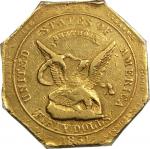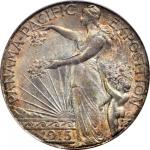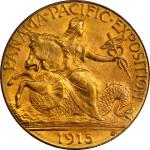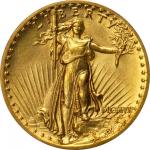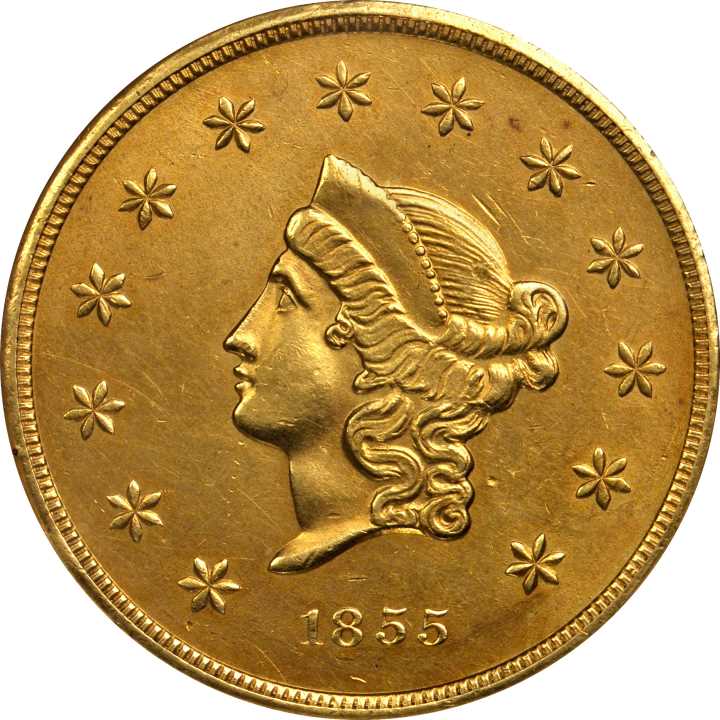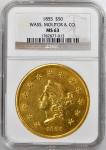Struck on a large, round gold planchet, the $50 gold pieces issued by Wass, Molitor & Co. are among the impressive coins produced during the California Gold Rush era. While these were popular in their day and numerous, nearly all sustained wear, sometimes heavy, as well as many marks and sometimes outright damage. There was also no contemporary numismatic interest in preserving these coins, and many that did find their way into collectors hands in later decades were often mishandled in misguided attempts to "improve" them. The result is that most extant examples are well worn, heavily abraded and/or impaired. The example we offer here, however, is remarkable in its level of preservation, and a delight to behold. This Choice Mint State rarity numbers among the finest known survivors of this elusive and conditionally challenging type. The strike is near-uniformly sharp over both sides, and the few areas that are a bit more lightly impressed still show pleasingly bold detail. The surfaces exhibit a bright, satiny texture with handsome khaki-orange patina. This phenomenal piece is uncommonly smooth in overall appearance for a California Gold Rush era $50 of any type. One of the finest and most important Wass, Molitor & Co. coins of any denomination that we have ever handled, and a lovely example that is destined for inclusion in a highly regarded collection. The story of Wass, Molitor & Company has its beginnings in the Austro-Hungarian Empire and the war for Hungarian independence of 1848 and 1849. Born in Hungary, Count Samuel C. Wass and Agoston P. Molitor both studied metallurgy in Germany before returning to their native country to pursue their careers in the Hungarian mining regions. There they remained until the winds of revolution that had been swirling around Europe swept into Hungary culminating in a declaration of independence from the Austro-Hungarian Empire on April 18, 1848. Quickly Poland allied with the Hungarian revolutionaries and war against Austria and the Hapsburg emperor spread throughout the region. The war was finally suppressed in October of 1849, and many of the pro-Hungarian independence revolutionaries were forced into exile, including both Wass and Molitor. Seeing opportunity in North America, many Hungarian expatriates arrived in the United States just as the California Gold Rush was gathering momentum. Arriving in California from the Old World, these immigrants found a booming economy struggling to cope with the pains of explosive growth. Within two years of the discovery of gold, the population in Northern California had quadrupled and continued to grow every day. Unfortunately, the money supply did not grow at the same rate and coinage of any sort was scarce. Transporting freshly mined gold to the mints back East was a long and arduous proposition and repeated petitions for a branch mint made to Congress back in Washington were met with opposition and would be held up for several years. While other parts of the country would address such monetary crises with currency, this was not the case in the West where paper was met with almost universal distrust. Indeed this was codified into Article IV section 34 of the 1849 California Constitution under Article IV section 34 which forbade any bank to "make, issue, or put in circulation, any bill, check, ticket, certificate, promissory note, or other paper, or the paper of any bank, to circulate as money." Gold dust proved useful as a stop-gap measure but could be easily adulterated and its purity could not be consistently assured. Many local jewelers and assayers attempted to fill the need for coin but these efforts met with varying degrees of success. Samuel Wass arrived in San Francisco in October 1850 and set immediately to work in the California gold fields. He produced a detailed geological report of the region which was published in the Alta California on January 13, 1851. Wass prefaced his report with the following explanation as to his reasoning behind his journey to the West: "Gentlemen-As a native of a mining country in Europe I have felt a great deal of interest in all that I have heard and read about this country. My curiosity was highly excited during my sojourn in the States, having received so many accounts of the extraordinary formations and riches of nature in California. I made up my mind to visit the place in the company with two friends…" Wass quickly established a reputation as a well-regarded expert in metallurgy and the latest mining technology from Europe. Sometime in early 1851, Molitor arrived to California and soon joined his fellow expatriate. On October 14, 1851, the pair announced the formation of Wass, Molitor & Co. as an assay office located on Montgomery Street below Bush Street. Success came quickly to the firm and they relocated to the fireproof building formerly occupied by banker and Civil War general Henry M. Naglee, on the corner of Montgomery Street and Merchant Street. There, they set up an extensive smelting operation and assay laboratory that was widely praised in the local newspapers for its modernity. At least one newspaper noted that the firm did not endeavor to produce their own coins but rather used whatever was on hand to pay depositors. This may have been the impetus for the assayers to contemplate entering the coining business. In January 1852, Wass, Molitor & Co. announced that they were prepared to begin producing what they referred to as "small coin" in $5 and $10 denominations. The purity levels fell below federal standard, so in order to compensate for this, the coins were intentionally made slightly heavier. Their coins soon fetched a premium in circulation and were eagerly accepted in trade. The amount of these coins that were struck is not known, but may have been sufficient that no further coining operations were required for the next two years. In the meantime, Congress finally granted approval for a branch mint to be established in San Francisco which commenced operations in 1854. The difficulty of acquiring the necessary parting acids for refining raw gold meant that it would be some time before the San Francisco Mint would be able to strike enough coins to relieve the region s monetary shortages. After an especially lengthy layoff at the Mint, in March 1855 a group of prominent merchants and bankers petitioned Wass, Molitor & Co. to resume coining operations. The firm responded in the Alta California that it was prepared to do so within a week. Shortly thereafter, Wass, Molitor & Co. resumed striking coins and produced $10, $20, and round $50 gold pieces. These, too, proved to be popular and circulated widely until the San Francisco Mint was able to produce the much-needed federal coin in a more consistent manner. Given the quick nature of the response to the merchants petition, it comes as no surprise that the design of the $50 piece is more functional than artistic. The bust on the obverse is small, seemingly more befitting a $20 coin. The reverse with its simple wreath surrounding the denomination resembles the contemporary fractional gold pieces. The May 16, 1855, Alta California reported that "Wass, Molitor & Co. have commenced issuing their fifty and twenty dollar pieces, at the rate of $38,000 per day. The coin is above the U.S. standard and is confidently received in trade throughout the State." The round shape also seems to have helped acceptance of the coins since they were easier to handle than their octagonal counterparts from the United States Assay Office of Gold. Despite their brief tenure in circulation at the tail end of the private gold issuing period, the $50 coins were readily absorbed into trade. By late 1855 Wass, Molitor & Co. s coins were no longer required. Sometime in late 1855 or early 1856, Wass, Molitor & Co. dissolved and reorganized as Wass, Usznay & Co. Around this time, Wass left the region but eventually returned to continue the assay business with his son. Agoston Molitor left for London in 1856 and did not return to the United States. Mint State examples of Wass, Molitor & Co. coins of any denomination are of the highest rarity. Both grading services have recorded a grand total of ten grading events at any Mint State level, numbers that certainly include resubmissions. Here is an astonishing survivor from one of the most storied of the California Gold Rush coiners. , Est. $350,000-$550,000



